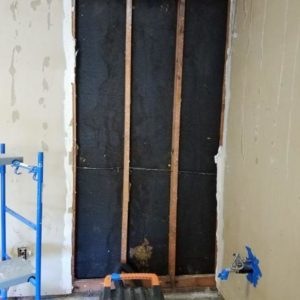Tar Papered Interior Wall Sheathing and Mold in the Cavity
Hello!
I have been beating my head all over the internet trying to find the answer to this so I thought I’d try asking here.
I recently purchased a house in the Seattle area. Having never even seen a basement before I moved here, I’ve had my hands full.
There was a musty oder in the walk out basement and the home inspector insisted that it was just old floorig and replacing it would fix everything. Famous last words….. As you can guess, when I pulled out the carpet I uncoverd a lot more than I bargained for!
Various events lead me to remove the painted paneling only to find mold at the top of the wall, underneath the kitchen area. I pulled down the drywall and found clear evidence of water leakage into the cavity. The majority of the mold visible in/on the insulation was on the drywall/kraft paper side though the staining on the tar paper (is it even tar paper?) shows that the moisture was on the sheathing, too.
A moisture meter tells me that all the materials are dried out but the smell tells me that the mold has been very happy in that cavity.. I am going to continue pulling out materials either from above or below until I can pinpoint the root cause but I need to start cleaning up the newly exposed mold to keep it under control as I work. This isn’t my first time dealing with mold in this way but it is the first time that I’ve seen this tar papered interior sheathing.
So here’s the question: Does that sheating hold mold? Can I even clean this stuff? I would just rip it out but it’s behind the studs and will require that I take the house apart from the outside so I’m hoping that there is a way to clean the cavity instead of basically burning the house down 🙁
I sprayed the area down with Concrobium (a mold treatment) to knock the smell down and I could see the lightly sprayed liquid wicking down the wall in the black material so I’m not sure if I’m seeing just staining or what. 
Any input you have is appreciated!




















Replies
The tar paper you see is just a typical old style moisture barrier to stop water that penetrates the siding. Anything can mold but I don't think I've ever seen any on tar paper. I would expect the asphalt in it would kill old spores. I would remove all the moldy drywall and anything else porous then spray everything down real well with OxyClean which will kill the mold spores with no risk to you. Obviously you need to find the source of the leak and fix that or the same think will happen again.
Based only on the picture, I can't tell if the black material is thin tar paper or a variation on "brown board" fiberboard sheathing (which is about a half inch thick).
What is on the other side of this wall? Is this an outside wall or a basement (below grade) wall or what?
Do be aware that very often what people think is "mold" isn't. Especially on masonry surfaces you often see "efflorescence" which is not mold but rather "salts" that leached out of the building materials (especially concrete, but also various "composite" buildling materials).
Today a breathable housewrap takes the place of tar paper and tar-treated wall sheathing. Tar-treated products create a non-breathable moisture barrier. In bygone times, when houses were drafty, this moisture barrier worked reasonably well, but no more!
The photo appears to show tar-treated fiberboard sheathing (in vogue in the 60's and 70's). If you have any doubts, clean the back of the sheathing (black) carefully. Remove and clean beyond the affected area. And be sure your plumbing is free of leaks. For complete peace-of-mind you could cut out the sheathing in the stud bays. To my way of thinking this is ok for a small area, since fiberboard sheathing does not add significant sheer value to the wall.
When you reside, consider removing the existing sheathing, replacing it with a sheer-rated product (OSB, plywood properly fastened) and housewrap.
First the good news... You own a house in Seattle. Congrats! That's not easy to do these days. You also don't seem to have an active leak since the area is dry. You should double check that especially since we haven't had any real rain in a few weeks, but it looks like it was an old leak coming from the kitchen above and has been fixed. The studs and top plate don't seem to be rotted out either so you won't need to tear the house down or even remove the exterior siding. Unless you really really want to for aesthetic reasons and have money to burn.
It's a little hard to tell in the photo if that's tar paper or tar covered fiberboard, but contrary to what a lot of people believe, tar paper is actually vapor permeable. Not moisture permeable, but vapor permeable. No, it's not as good a house wrap as some of the modern solutions like Zip system, but it works well enough on an older house like this.
Now for the mold...Removing the moisture damaged sheetrock is a good start and the Conchrobium is a good mold killer (a lot of the other cleaning solutions people recommend just clean the surface mold but don't kill remaining spores). Remove the remaining surface mold on the studs and then reapply Conchrobium again. With the water leak fixed there shouldn't be enough moisture to keep the mold growing back.